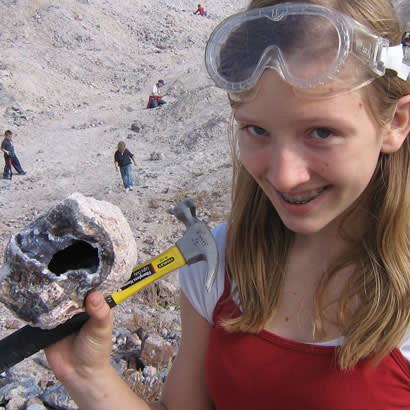
Looking for fun activities to enjoy with your grandchildren? Getting them into the great outdoors offers healthy and educational opportunities. Whether heading to the local park or enjoying an adventure in your own backyard, you can turn playtime into learning.
Being outdoors really “rocks!” “Rockhounding” is amateur geology, and it’s a terrific way to engage children and encourage them to learn. Kids love to play in the dirt, and you can turn it into an educational event. Create an area for them to mine by burying rocks, gems or whatever treasures you feel are appropriate. You can use a kitchen colander or make a sifter for them to unearth and identify the items. As HomeAdvisor explains, “[Rockhounding is] a great way to get your kids excited about science. It helps them understand basic concepts (like observation, examination, and cause and effect) in a more tangible way.” Even if you don’t create a geological dig in your backyard, you can take the kids hiking and collect rocks for identification. You and your grandchildren could make a rock garden to remember the experience, and they can label the different rocks they identify.
What’s “bugging” you? Entomology is another fun topic for kids. Entomology is the study of insects, and many children are fascinated by bugs, so it’s a natural choice. Some experts suggest observing and identifying insects on your backyard explorations. Children can learn the various insect structures to help classify bugs, such as the body type and number of legs.
Flights of fancy. Children are often enchanted by birds, so why not encourage them to learn and understand our feathered friends? KQED News recommends engaging them in local birdwatching outings, or you can plan events of your own. Learning about birds, known as ornithology, can encourage kids’ understanding of our ecological system and the importance of habitat.
Down and dirty. Another fun activity for kids is collecting soils for identification. You can get samples from outings in different places, such as the local park, on a hike in the woods and from your own backyard, and make comparisons in soil composition. Kids Discover suggests getting two cup samples and comparing small portions under a microscope. Children then look carefully and note textures along with whether there are sticks, leaves and other natural elements included. Have them journal their findings and make further scientific observations when seasons change. They will enjoy revisiting their notes and making evaluations.
Plant power. Being able to visualize what they are being told can help children grasp concepts. One idea is to show children how plants absorb water — the process known as osmosis — with a simple experiment. Put about eight ounces of water in several clear glasses, then color the water with food coloring. Cut stalks of celery and set them into the water, cut sides down, and allow your grandkids to watch the celery absorb the colored water. Over the course of a day or so, the celery stalks will change hues as they pipe the colored water into their stems and leaves.
Out of this world! Do your grandchildren enjoy watching the night sky? NASA offers a great online tool they are sure to find fascinating. Kids can enroll in the program designed to improve and participate in the government’s study of Mars. At their Be A Martian website, children engage by creating their own Martian identity, becoming citizens of Mars and viewing satellite data. They can also learn how to find Mars and other celestial bodies in the night sky by firsthand observation, enhancing the experience.
Explore and learn. The great outdoors offers learning opportunities aplenty for your grandkids. From your own backyard to your local parks, you’ll find lessons abound in every nook and cranny. With these terrific ideas, you can offer them educational and fun adventures!

